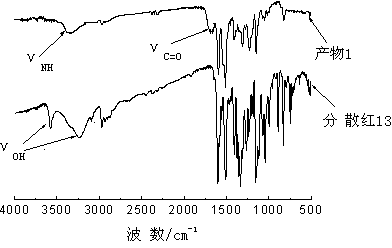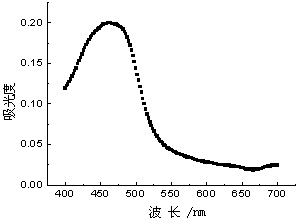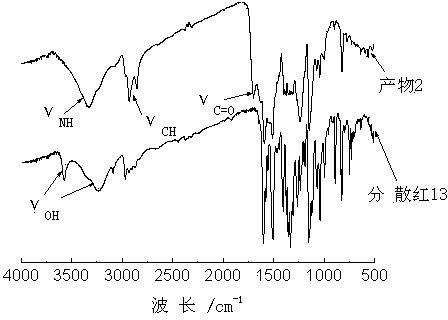Crosslinking modification method of azo-disperse dye
A technology of disperse dyes and cross-linking modification, applied in the preparation of azo dyes, azo dyes, dyeing methods, etc. problem, to achieve the effect of improving heat-resistant migration, increasing molecular weight, and improving affinity
- Summary
- Abstract
- Description
- Claims
- Application Information
AI Technical Summary
Problems solved by technology
Method used
Image
Examples
Embodiment 1
[0043] Disperse Red 13 and diphenylmethane-4.4' diisocyanate (MDI) crosslinked
[0044] Reactant Molecular Formula:
[0045]
[0046] Product 1 Molecular Formula
[0047] Synthesis:
[0048] Weigh 2.0 grams of Disperse Red 13 parent dye purified by recrystallization and vacuum drying, add in a 1000ml three-necked flask equipped with a reflux device (connected to a calcium chloride drying tube), add 600ml of toluene through dehydration, and start magnetic stirring , to dissolve the dye, add 10ml of stannous octoate, and gradually heat up to 85°C. Accurately weigh 0.7155 g of diphenylmethane-4.4' diisocyanate (MDI), dilute and dissolve with 40 ml of toluene solvent, slowly drop it into the reactor within 120 min, continue the heat preservation reaction for 2 h, stop heating, cool to room temperature, the product Precipitated, and obtained 1.31 g of the product by filtration, with a yield of 48.24%.
[0049] Molecular Characterization:
[0050] (1) 1 H NMR (400MHz, DMSO):...
Embodiment 2
[0064] Disperse Red 13 and Hexamethylene Diisocyanate (HDI) Crosslinked
[0065] Reactant Molecular Formula:
[0066]
[0067] Product 2 Molecular Structural Formula
[0068] Synthesis:
[0069] Weigh 2.0 grams of Disperse Red 13 parent dye purified by recrystallization and vacuum drying, add in a 1000ml three-necked flask equipped with a reflux device (connected to a calcium chloride drying tube), add 600ml of toluene through dehydration, and start magnetic stirring , to dissolve the dye, add 10ml of stannous octoate, and gradually heat up to 85°C. Accurately weigh 0.4879 g of hexamethylene diisocyanate (HDI), dilute and dissolve it with 40 ml of toluene solvent, slowly drop it into the reactor within 120 min, continue the heat preservation reaction for 2 h, stop heating, cool to room temperature, the product precipitates, and the Filtration afforded 0.7972 g of product, a 32.04% yield.
[0070] Molecular Characterization:
[0071] (1) 1 H NMR (400MHz, DMSO): 1.13(t...
Embodiment 3
[0085] Disperse Orange 3 and diphenylmethane-4.4' diisocyanate (MDI) crosslinking
[0086] Product Molecular Structural Formula:
[0087]
[0088] Product 3 Molecular Structural Formula
[0089] Synthesis:
[0090] Weigh 2.0 grams of Disperse Orange 3 parent dye purified by recrystallization and vacuum drying, add it to a 1000ml three-necked flask equipped with a reflux device (connected to a calcium chloride drying tube), add 600ml of toluene through dehydration, and start magnetic stirring , to dissolve the dye, add 10ml of stannous octoate, and gradually heat up to 85°C. Accurately weigh 0.8879 g of diphenylmethane-4.4' diisocyanate (MDI), dilute and dissolve it with 40 ml of toluene solvent, slowly drop it into the reactor within 120 min, continue the heat preservation reaction for 2 h, stop heating, cool to room temperature, the product Precipitated, obtained 2.3718 g of product by filtration, and the yield was 82.13%.
[0091] Molecular Characterization:
[0092...
PUM
 Login to View More
Login to View More Abstract
Description
Claims
Application Information
 Login to View More
Login to View More - Generate Ideas
- Intellectual Property
- Life Sciences
- Materials
- Tech Scout
- Unparalleled Data Quality
- Higher Quality Content
- 60% Fewer Hallucinations
Browse by: Latest US Patents, China's latest patents, Technical Efficacy Thesaurus, Application Domain, Technology Topic, Popular Technical Reports.
© 2025 PatSnap. All rights reserved.Legal|Privacy policy|Modern Slavery Act Transparency Statement|Sitemap|About US| Contact US: help@patsnap.com



